If you consider Information as the critical currency that needs to flow unimpeded within any team, then psychological safety is the lifeblood that transports this vital teaming nutrient. In teams or organizations where psychological safety does not exist, information clots will easily form regardless of the size of point-to-area or area-to-point pathways. Teams with information clots lose their ability to notice or detect weak signals, significantly reducing a team’s agility and resilience.
What I just described is a flow system where constraints—boundaries or features that shape the form of a complex adaptive system—interact to create emergent behaviors. Flow systems, according to Adrian Bejan, have two basic features: (1) the current that is flowing and (2) the design through which it flows [1].
Teams, according to Amy C. Edmondson and other team science researchers including fellow Flow System co-creator, UNT Professor John Turner, are complex adaptive systems where interactions create unpredictable dynamics and the whole is greater than the sum of its parts [2].

A Team is a Flow System
What is missing from this discussion is the optimal teaming or teamwork design—a noun that describes the configuration for which a currency flows [1]. For teams, we know from team science that team frameworks have three basic components: Plan, Execute, and Assess. Missing from this basic team framework is sense-making—how do we make sense of our environment so we can act in it [3].
I offer that High-Performing Teams—those teams that go beyond their customers’ expectations and where each member of the team is individually satisfied—use sense-making to create a competitive advantage.
Sense-Plan-Act-Assess and the OODA loop
The teamwork design that captures this teaming approach of Sense-Plan-Act-Assess and works at multiple timescales is John Boyd’s Observe-Orient-Decide-Act (OODA) loop. The OODA loop is a learning and adaption process ideal for finite and infinite games. It is often considered a decision-making process but it is best described as “an open-ended, far from equilibrium process of self-organization, emergence and natural selection [4].” Arguably, the OODA loop can represent both a complex adaptive system and a flow system.

The OODA loop contains a sense-making loop, two planning or decision pathways, an Action step (Act), and two feedback or assessment pathways. The pathways are often more important than the OODA loop’s action steps as mental models, schema, and repertoire found in the IG&C pathways act as the constraints needed to build high-performing teams.

Sense-Making
Within the OODA loop’s sense-making loop—the loop represented by the interplay of Observation, the feedforward pathway, Orientation, and the Implicit Guidance and Control (IG&C) pathway—individual team member’s heuristics or biases are represented by the components found inside the Orientation step: Synthesis/Analysis, Cultural Traditions, New Information, Genetic Heritage, and Previous Experience.
To leverage cognitive diversity represented by the heuristics found in the OODA loop’s Orientation step mentioned above, psychological safety needs to exist and interact with expert team sense-making repertoire or schema. These repertoire or schema may include the Cynefin framework, Wardley Maps, Red Teaming, and Complex Facilitation Techniques. However, without psychological safety, team sense-making will suffer as individual team members will be hindered by personal fear, forcing them to withhold valuable information.
Planning
For planning and decision-making, the OODA loop offers up two pathways: (1) the explicit pathway from Orient to Decide-to-Act and (2) the implicit pathway moving from Orient though the IG&C pathway to Act. Expert or high-performance team shared mental models of planning act as a constraint along the IG&C pathway, essentially providing more access for information to flow.


Assess (Feedback Loops)
The OODA loop has two feedback or assessment pathways moving from Act to Observe. These two pathways exist so teams can separate the decisions or plans made from the outcomes achieved. Why is this? In complexity, the best decisions may lead to unfavorable outcomes and bad decisions may lead to favorable outcomes. To maximize the potential of favorable outcomes, teams must examine the repertoire, schema, or mental models they use in their sense-making, decision-making, execution, and assessment processes—their teaming skills also known as relationships, interactions, non-technical skills, the hard skills, soft skills, etc.
In our High-Performance Teaming workshops, we show teams and leaders how psychological safety interacts with expert team shared mental models, schema, and repertoire to improve their OODA loops. In other words, we help optimize flow.
[1] Bejan, A., Zane, J.P. () Design in Nature: How the Constructal Law governs evolution in biology, physics, technology, and social organization
[2] Various conversations with Professor John Turner and from Edmondson, A. C. (2012). Teaming: How Organizations Learn, Innovate, and Compete in the Knowledge Economy. San Francisco, CA: Jossey-Bass.
[3] From various conferences and retreats with Dave Snowden
[4] Boyd, The Essence of Winning and Losing, 5.




